

ZIGGURAT:
TERRESTRIAL MEGALITHIC GRID TECHNOLOGY OF REMOTE ANTIQUITY
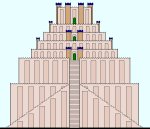
Etemenanki ziggurat
ZIGGURAT: Pyramid of Prehistoric Antiquity (ante-diluvial Sumeria) (Sitchin)
First established [ante-diluvial; c.350,000 BCE (Sitchin)] was Home in Faraway Built (Eridu), which functioned as the first gold extracting facility at the edge of the Persian Gulf, and abode of Enki. The spaceport was built at Bird City (Sippar), which was aligned on center with the flight corridor. Bright Place Where the Ores are Made Final (Bad-Tibira), the smelting and refining center, and Place of the Utmost Well-Being (Shuruppak), the medical center, was laid out on center, from the landing corridor’s entrance. Earth Place of Nibiru (Nibruki) [Akkadian: Crossing Place on Earth (Nippur)], served as the mission control center, located in the exact center of the landing corridor. At Nibiruki was a raised platform, Place of Earth’s Root (Kiur), with antennas, ascending to a secret communication chamber (from Earth to the Igigi), the holy of holies, the Dark, Glowing Chamber (Dirga) [sim.Hebrew: Ark of the Covenant], where vital star charts and orbital data panels, the Tablets of Destinies, were installed, and the Bond of Heaven and Earth (Duranki), a true axis mundi, was maintained. The structure became the prototype for all ziggurats and pyramids (eg.Tower of Babel) to come.
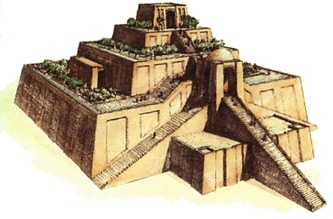

Ziggurat of Ur
Seven Staged Ziggurat: (related to Earth Stations and Heaven Stations)
The ziggurat [Sumerian: “supreme;” “most high” (esh); Hebrew/Akkadian: “fire;” numerical entity relating to the “measuring” aspect of the ziggurat (esh); Akkadian/Babylonian: “tube of divine spirit” (zukiratu)] oriented precisely on axis with the cardinal directions (N,S,E,W), functioned as the Bond of Heaven and Earth (Duranki), the abode of the reigning deity (eg. Marduk) (top stage), and an observatory of the horizon at seven specific angles (for each ziggurat stage). Using the principles of sexagesimal mathematics, the Sumerians defined the gar (1 gar = 12 short cubits = 6m = 20 ft.) to quantify units of space, relative to the angle of horizon observation and Earth latitude, in ziggurat design.
Ziggurat with seven views to the horizon from each stage.

Ziggurat stages relate to planetary stations relative to the sun circuit of Nibiru (home planet of Anunnaki), from outside to inside the solar system, with 7 designating the position of Earth.
Dimensions:
Length and Height (base): 15 gar = 180 cubits = 300 feet » football field in length (ziggurat sculpted from a cube)
Area (square base): 15X15 gar = 225 sq.gar
Volume (cube): circumference = 60 gar
Total of lengths of the seven stages: 60 gar (approx.)
[15 relates to Chinese luoshu; 60 relates to sun circuit of Nibiru when squared (3600); and zodiac age when cubed and divided by 100 (2160)]
|
STANDARD ZIGGURAT DIMENSIONS |
|||
|
Stage |
Length |
Height (x6 to derive <) |
Angle |
|
1 |
15 |
5.5 |
33° |
|
2 |
13 |
3 |
51° |
|
3 |
10 |
1 |
57° |
|
4 |
8.5 |
1 |
63° |
|
5 |
7 |
1 |
69° |
|
6 |
5.5 |
1 |
75° |
|
7 |
4 |
2.5 |
90° |
Giza/Heliopolis (An): Pyramid Beacons (Sitchin)
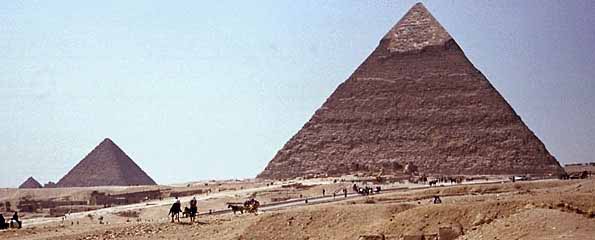
Great Pyramid of Giza.
Counter balancing the natural beacons of the twin peaks of southern Sinai, the Giza pyramids were built (sometime before 23,000 BCE) to serve as a guiding beacon for Anunnaki spacecraft. The Great Pyramid, with its two companion pyramids and sphinx, is situated precisely on the extended line through Mount Ararat and Baalbek.
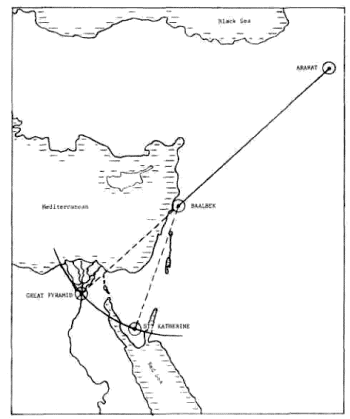
Post-diluvial landing corridor of the Anunnaki.
The Raised Land: After the Deluge
According to the Egyptians, after the Deluge, the Anunnaki returned to Earth but abandoned the original region of Sumer, which remained too flooded for civilization, and settled in the Nile region. The Anunnaki went into Egypt via the Red Sea, the Place of the Gods (Ta Neter). The realization that the names of the olden gods only have meaning in Akkadian, mother of all Semitic languages, further reinforces the Sumerian origin of the Egyptian gods.
Egypt was nicknamed “The Raised Land,” for the Egyptians believe that a powerful deity of remote antiquity, Ptah [Semitic: “he who fashioned things by carving and opening up”; Sumerian: Enki], nicknamed the Developer, raised Egypt from the muddy waters of the Nile by engineering an extensive dyking and damming system. After Ptah left Egypt for the south, he continued to control the Nile from sluices he installed in secret subterranean twin caverns on the island of Abu [Greek: Elephantine], located at the first cataract of the Nile (Aswan). Memphis was built on an artificial mound, which functioned as part of the waterworks system on the Nile.

Ra [sim.Sumerian: Marduk] manifested periodically as a Celestial Disc (Aten), depicted as a winged globe.
As in Sumerian tradition, the Egyptians held that originally the Gods of Heaven came to Earth via a Celestial Disk. Ptah, a creator god, was considered the Chief Craftsman of the Gods, being a scientist, master engineer and architect. Before leaving Egypt for the south, Ptah built the religious center of An [Biblical: On; Greek: Heliopolis], where he installed his son, Egypt’s first divine ruler, Ra [Sumerian: Marduk; Semitic nickname: Tem (the Complete, the Pure One)]. There at An, Ra housed his heavenly transport, a “secret object; pyramidion bird” (ben-ben).

Egyptian Bennu bird
Great Pyramids of the Anunnaki: Post-Diluvial Ekur
The pyramids of the Egyptian Old Kingdom give no concrete evidence (ie. no burial chambers or sarcophagi; not including intrusive burials) to support their function as burial tombs, because they were not meant for human tombs. The pyramids functioned initially as guiding beacons for the pharaoh’s ethereal soul (ka) to the Ascending Place, as well as for the flight of Anunnaki spacecraft. The pharaohs actually attempted to build temples, not tombs, that emulated, not the pyramid of Zoser, but the Giza pyramids built by the Anunnaki. While Ninurta dammed and irrigated the water of Sinai, and Utu who commanded its spaceport, it was the generations of Enkite gods who contributed to the flight corridor of antiquity the Great Pyramid, the Formidable House Which is Raised Up Like a Heap (Miscellaneous Babylonian Texts), the House Which is Like a Mountain. The Great Pyramid was conceived by Enki, designed by his son Marduk [Egyptian: Ra], built by Geb, equipped by Thoth, and defended by Nergal.
Feature Similarity with Sumerian Ekur:
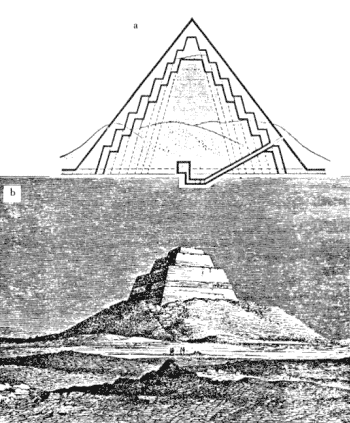
Post-Giza step pyramids of Sakkara.
Perhaps the divine builders of the pyramids updated the ante-diluvial Sumerian ziggurat to the light reflecting true pyramid of post-diluvial Egypt, for the initial purpose of functioning as sharper directional shadow pointers in the sand, as well as being white guiding beacons. The pyramids of Giza have great similarity to the antediluvian ziggurat of Enlil, the Ekur (House Which is Like a Mountain) of Nippur, which housed the Duranki (mission control center communicating between Heaven and Earth) and the Dirga (Dark Chamber which served as a guidance beacon for spacecraft landing at Sippar). The Great Pyramid of Giza, like the Sumerian Ekur, was sloped at 52º (number of Thoth), designed with dark chambers, and equipped with an aerial guidance system. To assure its neutrality, the Great Pyramid was put under the patronage of Ninhursag, mistress of the House With a Pointed Peak.
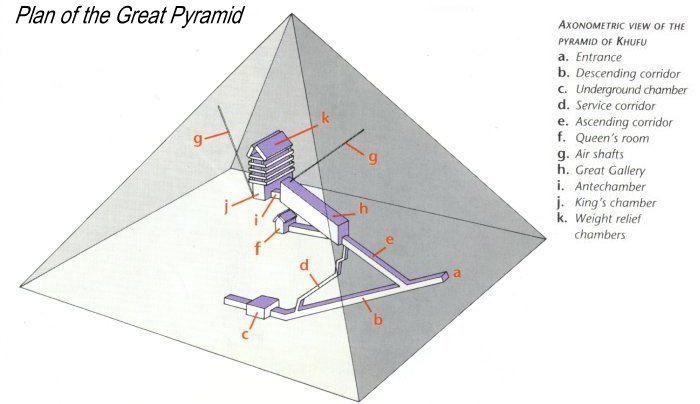
Pyramid Functions:
Geographical Landmark which anchored (with Mount St. Katherine) the Anunnaki Flight Corridor: artificial twin peaks
Upgraded Space Guidance Beacon
Communication system: oracle center
Delineated the neutrality zone of the Three Ways (between Enlil and An) (see Silk Road)
Impregnable Defense System: ray-emitter (with Water Stone Apex in place)

Tower of Power: Gateway of the Gods (Bab Ili); End of Peace (3450 BCE)
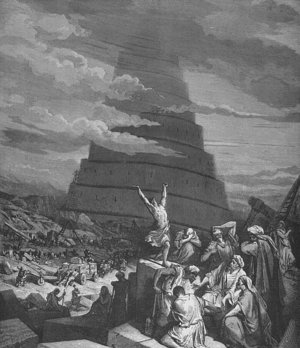

Soon after people resettled in the Land of Sumer [Biblical: Shinar], they built dwellings made from bricks of fired clay, held together by mortar of pitch, and a tower, whose head could reach unto the heavens. The tower was reminiscent of the dominant architectural feature of ancient Babylon, the ziggurat, or seven-stage pyramid, a launch tower for a sky chamber (shem; mu), the House Whose Head is Lofty (Esagila).
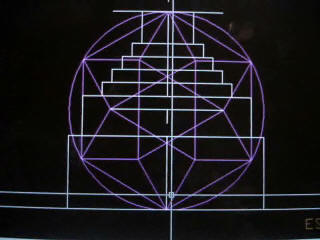
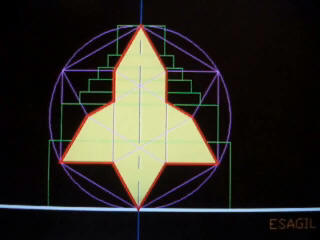
Brueghel Tower of Babel depiction
According to the Book of Genesis, and the writings of Berossus (Sayce), at one time, humanity spoke in unison. When Yahweh witnessed the capability of their accomplishment, realizing their infinite potential, he intercepted their progress (with a whirlwind) by confusing their language and dispersing their people throughout the Earth. But according to the root Akkadian version of the Sumerian tale of the Tower of Babylon found in Ashurbanipal’s library in Nineveh (Smith) (Polyhistor, c.100 BCE), humanity was only a pawn in the struggle, while the gods were the true instigators of the incident.

Esagila
Various Sumerian legends allude to this event through the apparent effort of Ea to enlist men to gain control over the Nefilim space facilities, another incident within the ongoing feud between Ea and Enlil, which incidentally had been passed down to their offspring (Marduk and Ninurta). The Tower of Babylon [Akkadian: Gateway of the Gods (Bab Ili); Hebrew: Babel] incident was the result of Marduk’s congenital envy to command Babylon, through the corruption of their people to sin through the covert instigation of a magnificent building endeavor.

Nineveh depiction
After Enlil learned of Marduk’s work, he appealed to his father Anu for intelligence of heart, and to Marduk’s mother, Damkina, who supported her son. Then Nunamnir [Enlil] ascended in a Whirlwind, speaking from Heaven to Earth, attempting to persuade the rebels to abort their cause, but instead they violently opposed. After failing to stop the opposing rebel gods, Enlil descended to Earth and gave the command to their counsels to confuse them, thus stopping their progress. (Second instance from the Deluge when Enlil becomes disgusted with humanity.)
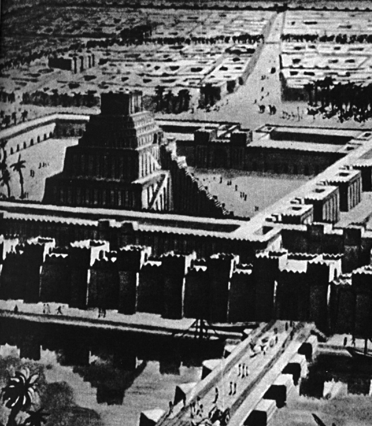
Eventhough Marduk failed to prevent the transfer of kingship from Kish to Uruk and Ur, destined to be under the command of Nannar and his offspring, and to seize control over his own city, Babylon, the Tower of Babylon incident became a catalyst for a series of tragic events which ended the longest era of peace in human history.
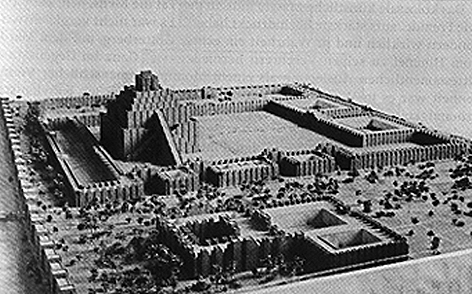

Ancient Wars of Kings:
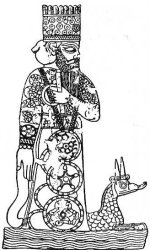
Babylonian depiction of Marduk as divine king
Incarceration of Marduk: Prisoner in the Pyramid (3450-3100 BCE)
According to Mesopotamian texts, Marduk was imprisioned in the Mountain Tomb (Great Pyramid of Giza). For his attempted conspiracy to overthrow Babylon, Marduk was banished from his cult center in Babylon and Mesopotamia, and thus returned to Egypt. There in Heliopolis (An), seeking supremacy over Egypt, Marduk quickly reestablished his cult center by installing a display of celestial objects in a temple shrine (Het-Benben).
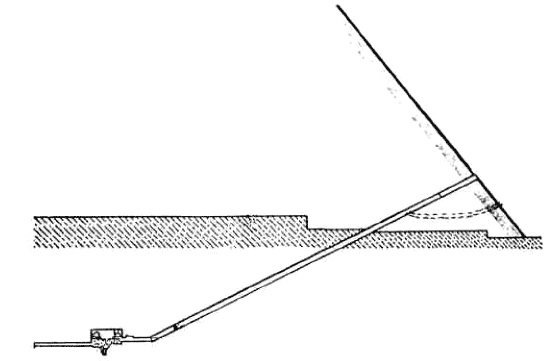

Internal Great Pyramid: descending and ascending (leads to "Queen's Chamber") passages at 26°, and Al Mamoon's (c.820 CE) blasted entry passage
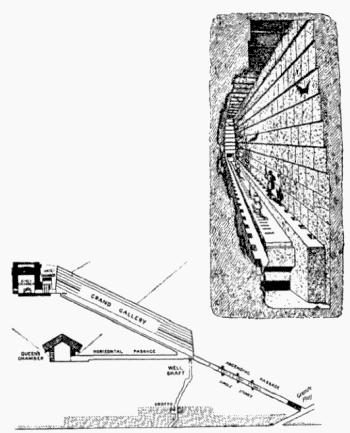
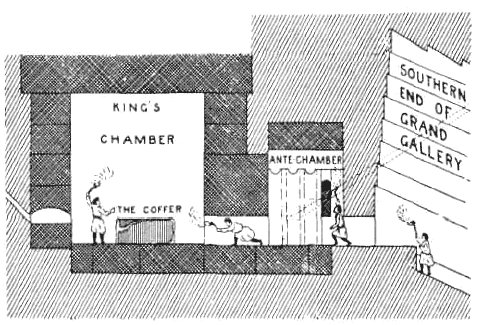
Internal Great Pyramid: ascending passage, Grand Gallery, "Queen's Chamber," "King's Chamber," and ante-chamber
Since Thoth did not put up a struggle [after being banished, possibly chose new abode with disciples in New Realms of Mesoamerica, c.3100 BCE; Mesoamerican Long Count began 3113 BCE; sim.Mesoamerican Winged Serpent (Quetzalcoatl) (see below)], and Nergal and Gibil situated too distant from the center of power, the younger son of Enki, Dumuzi, who ruled the domain bordering Upper Egypt, was the only rival remaining. Fueling Dumuzi’s ambitions was his bride, Inanna (granddaughter of Enlil), who elevated Marduk’s suspicion and animosity.
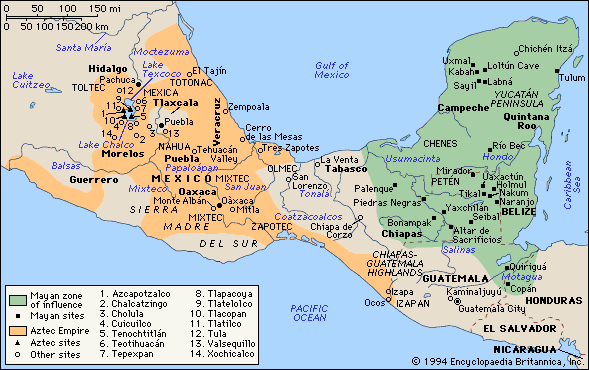
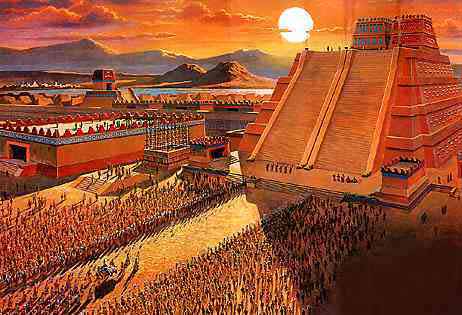
Recruitment of Nergal:
The Sumerian text Erra Epos, blames Nergal [Sumerian epithet: Servant of Ra (Erra)] for the events preceeding nuclear disaster. After accepting the mission, Nergal journeyed to Mesopotamia to meet with Marduk. He first stopped in Uruk to meet with Ishtar, before meeting Marduk at the Temple of Heaven and Earth (Esagil) in Babylon. There, Nergal praised Marduk for his ingenius waterworks, but reprimanded him for depriving other cities of water, particularly the city of Anu (Uruk), thus going against the will of the Anu and the Anunnaki. But Marduk’s citations of the Anunnaki deviations in the plan for post-diluvial Earth (ie. shifting of the flight corridor, establishment of new settlements without returning to the old settlements, the destruction and confiscation of divine artifacts), justified his independent actions.
Dethroning Marduk from Babylon:
Marduk was bothered Nergal’s discounting of certain divine artifacts, the Oracle of the Gods (instrument of giving orders), the Holy Scepter (the icon which contributes brilliance to kingship), and the Radiating Stone (weapon of disintegration). Marduk warned that if he should be dethroned, and the Brilliance of the underground waterworks (Gugunu) removed, chaos (ie. darkness, confusion, draught, famine, disease) would occur. Nergal offered to return the divine artifacts to Marduk, on the conditions that he step down from his seat in Babylon and return to the Lower World to receive the artifacts, and permit Nergal to enter the Esagil to erect the Winged Bulls of Anu and Enlil, while promising not to disturb the waterworks.
Removing the Brilliance from the Gugunu:
Successfully persuaded by the promise of Nergal, Marduk left Babylon for Africa. Immediately after Marduk left, Nergal ventured into the restricted underground chamber (Gugunu) of the Esagil, and removed the source of its radiating brilliance. Consequently, per Marduk’s warning, the day turned to darkness, the flooding was disarrayed, the lands wasted, and the people perished.
Destruction of the Esagil:
Ea, Nannar, and Utu became angry with Nergal, for their Mesopotamian cities were affected. The people made sacrifices to Anu and Ishtar to no benefit. Ea ordered the statue of Nergal destined for the Esagil be taken away. Enraged about losing his influence, Nergal destroyed the Esagil and returned to Kutha (Africa), leaving his Kuthean henchmen behind in Asia (Lands of Shem) to establish garrison-settlements in Samaria [Biblical] and Elam.